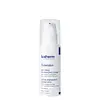What's inside
What's inside
 Key Ingredients
Key Ingredients

 Benefits
Benefits

 Concerns
Concerns

 Ingredients Side-by-side
Ingredients Side-by-side

Water
Skin ConditioningGlycerin
HumectantCetearyl Alcohol
EmollientCetyl Alcohol
EmollientPropanediol
SolventPalmitic Acid
EmollientStearic Acid
CleansingCetearyl Glucoside
EmulsifyingCeramide NP
Skin ConditioningCeramide Ns
Skin ConditioningCeramide As
Skin ConditioningCeramide AP
Skin ConditioningCeramide EOP
Skin ConditioningSaccharide Isomerate
HumectantPhytosteryl/Octyldodecyl Lauroyl Glutamate
Skin ConditioningPCA
HumectantCholesterol
EmollientArginine
MaskingHydrogenated Lecithin
EmulsifyingCitric Acid
BufferingSodium Citrate
Buffering1,2-Hexanediol
Skin ConditioningCaprylyl Glycol
EmollientTropolone
Skin ConditioningCarbomer
Emulsion StabilisingDipropylene Glycol
HumectantGlyceryl Stearate
EmollientWater, Glycerin, Cetearyl Alcohol, Cetyl Alcohol, Propanediol, Palmitic Acid, Stearic Acid, Cetearyl Glucoside, Ceramide NP, Ceramide Ns, Ceramide As, Ceramide AP, Ceramide EOP, Saccharide Isomerate, Phytosteryl/Octyldodecyl Lauroyl Glutamate, PCA, Cholesterol, Arginine, Hydrogenated Lecithin, Citric Acid, Sodium Citrate, 1,2-Hexanediol, Caprylyl Glycol, Tropolone, Carbomer, Dipropylene Glycol, Glyceryl Stearate
Water
Skin ConditioningGlycerin
HumectantC9-12 Alkane
SolventPEG-8
HumectantButyrospermum Parkii Butter
Skin ConditioningCera Alba
EmollientCetyl Alcohol
EmollientDiethylhexyl Succinate
EmollientNylon-12
Caprylyl Glycol
EmollientLactitol
HumectantXylitol
HumectantStearic Acid
CleansingPalmitic Acid
EmollientEthylhexylglycerin
Skin ConditioningXanthan Gum
EmulsifyingSclerotium Gum
Emulsion StabilisingCoco-Caprylate/Caprate
EmollientCetyl Hydroxyethylcellulose
Emulsion StabilisingSodium Polyacrylate
AbsorbentSodium Hydroxide
BufferingHydrated Silica
AbrasiveSilica Dimethyl Silylate
EmollientDisodium Phosphate
BufferingSodium Phosphate
BufferingWater, Glycerin, C9-12 Alkane, PEG-8, Butyrospermum Parkii Butter, Cera Alba, Cetyl Alcohol, Diethylhexyl Succinate, Nylon-12, Caprylyl Glycol, Lactitol, Xylitol, Stearic Acid, Palmitic Acid, Ethylhexylglycerin, Xanthan Gum, Sclerotium Gum, Coco-Caprylate/Caprate, Cetyl Hydroxyethylcellulose, Sodium Polyacrylate, Sodium Hydroxide, Hydrated Silica, Silica Dimethyl Silylate, Disodium Phosphate, Sodium Phosphate
Ingredients Explained
These ingredients are found in both products.
Ingredients higher up in an ingredient list are typically present in a larger amount.
Caprylyl Glycol is a humectant and emollient, meaning it attracts and preserves moisture.
It is a common ingredient in many products, especially those designed to hydrate skin. The primary benefits are retaining moisture, skin softening, and promoting a healthy skin barrier.
Though Caprylyl Glycol is an alcohol derived from fatty acids, it is not the kind that can dry out skin.
This ingredient is also used as a preservative to extend the life of products. It has slight antimicrobial properties.
Learn more about Caprylyl GlycolCetyl Alcohol is a fatty alcohol. Fatty Alcohols are most often used as an emollient or to thicken a product.
Its main roles are:
Though it has "alcohol" in the name, it is not related to denatured alcohol or ethyl alcohol.
The FDA allows products labeled "alcohol-free" to have fatty alcohols.
Learn more about Cetyl AlcoholGlycerin is already naturally found in your skin. It helps moisturize and protect your skin.
A study from 2016 found glycerin to be more effective as a humectant than AHAs and hyaluronic acid.
As a humectant, it helps the skin stay hydrated by pulling moisture to your skin. The low molecular weight of glycerin allows it to pull moisture into the deeper layers of your skin.
Hydrated skin improves your skin barrier; Your skin barrier helps protect against irritants and bacteria.
Glycerin has also been found to have antimicrobial and antiviral properties. Due to these properties, glycerin is often used in wound and burn treatments.
In cosmetics, glycerin is usually derived from plants such as soybean or palm. However, it can also be sourced from animals, such as tallow or animal fat.
This ingredient is organic, colorless, odorless, and non-toxic.
Glycerin is the name for this ingredient in American English. British English uses Glycerol/Glycerine.
Learn more about GlycerinPalmitic Acid is a fatty acid naturally found in our skin and in many plant and animal sources. In cosmetics, it is usually derived from palm oil. It serves many purposes in skincare, acting as a cleanser, emollient, and emulsifier.
As an emollient, palmitic acid helps soften and smooth the skin by preventing water loss. In cleansers, it helps remove oil and dirt while creating foam.
Its emulsifying properties help stabilize products by keeping water and oil-based ingredients from separating.
This may not be suitable for fungal acne-prone skin, as fatty acids like this can sometimes trigger breakouts in sensitive individuals.
Learn more about Palmitic AcidStearic Acid is a fatty acid. It is an emollient, emulsifier, and texture enhancer.
As an emollient, stearic acid helps soften skin. It aids the skin's protective barrier by preventing water loss. It also provides a gentle cleansing effect without stripping away natural oils.
Stearic acid may also be used to enhance the texture of products. It can add volume and stabilize ingredients such as water and oil. This can help water and oil ingredients from separating.
Sources of stearic acid include animal or vegetable fats/oils such as coconut or shea. It can be naturally found in butter, cocoa butter, shea butter, vegetable fats, and animal tallow.
This ingredient may not be Malassezia folliculitis, or fungal-acne safe.
Learn more about Stearic AcidWater. It's the most common cosmetic ingredient of all. You'll usually see it at the top of ingredient lists, meaning that it makes up the largest part of the product.
So why is it so popular? Water most often acts as a solvent - this means that it helps dissolve other ingredients into the formulation.
You'll also recognize water as that liquid we all need to stay alive. If you see this, drink a glass of water. Stay hydrated!
Learn more about Water